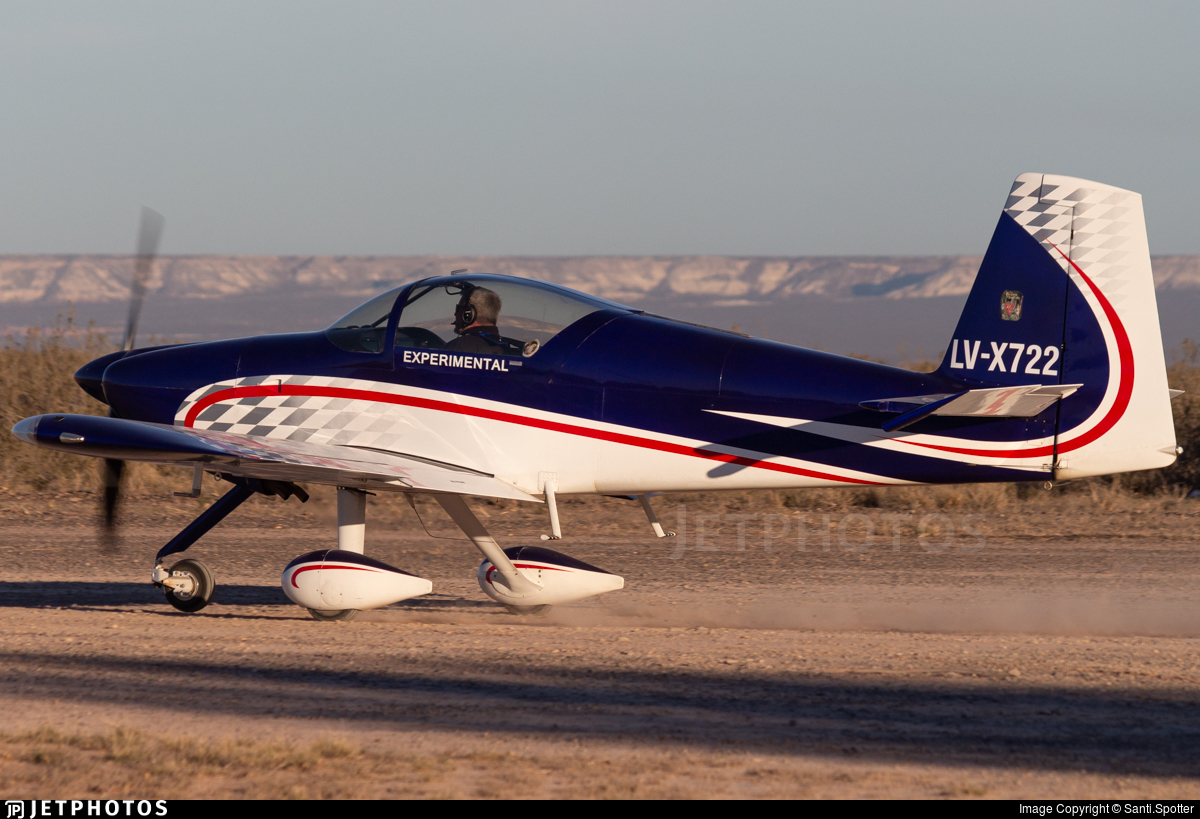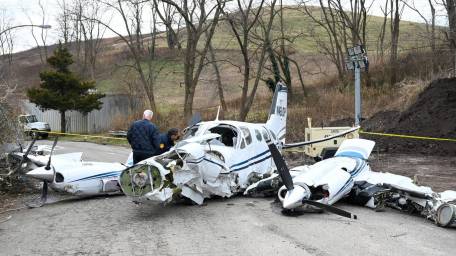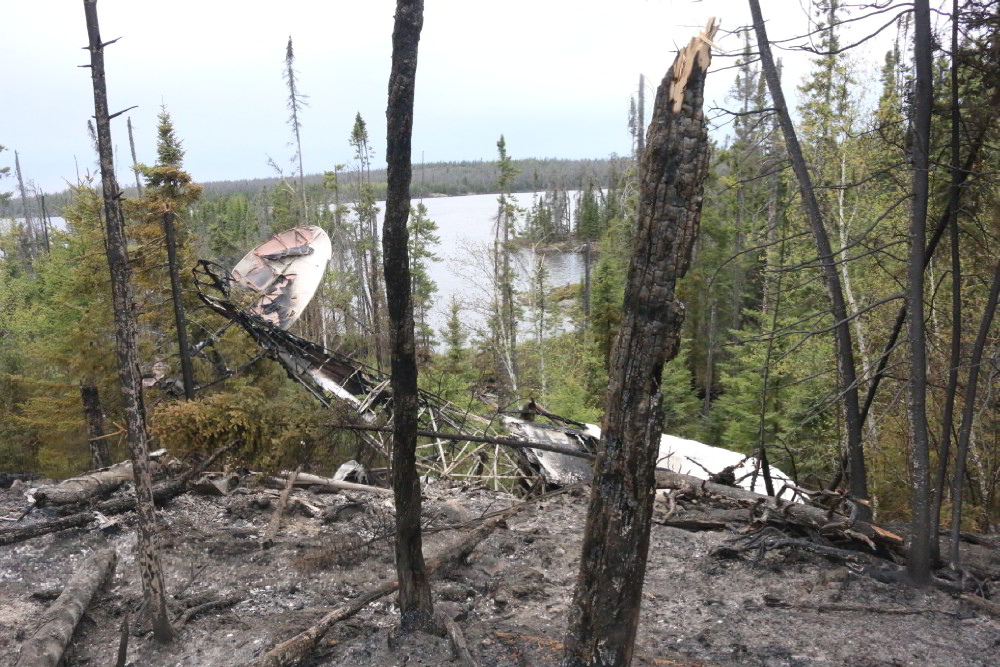
Transportation Safety Board of Canada – Link
Reproduction of this publication is meant solely for educational purpose to help prevent accidents and inform the public and Pilots.
Collision with terrain
Piper PA-12S Super Cruiser, C-FYDN (private)
Domain Lake, Ontario
28 May 2019
History of the flight
On 28 May 2019, at approximately 1503,Footnote1 the pilot of a privately owned, float-equipped Piper PA‑12S Super Cruiser (registration C-FYDN, serial number 12-1574) advised Kenora RadioFootnote2 of his intention to depart westbound from a private dock located on Red Lake, Ontario.
The pilot, who was sitting in the front seat, was on a visual flight rules (VFR) flight to Domain Lake, Ontario. The purpose of the flight was to transport 2 passengers from an outpost camp at Domain Lake to a second outpost camp at Optic Lake, Ontario. The passengers were employees of the pilot, who owned both the aircraft and the outpost camps.
Just before departing from Red Lake, the pilot sent a flight itinerary by text message to a responsible person.Footnote3 The intended route of flight was from Red Lake to Domain Lake, then to Optic Lake, back to Domain Lake, then back to Optic Lake, and finally returning to Red Lake by 2130 (Figure 1).
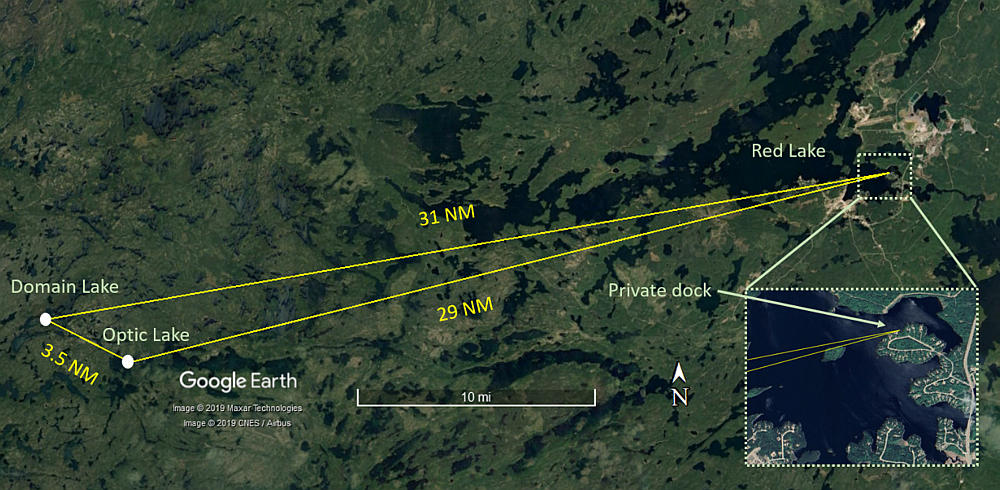
At 1505, Kenora Radio advised the pilot that the current wind at the Red Lake Airport (CYRL), Ontario, was 240° magnetic at 10 knots gusting to 19 knots and that the altimeter setting was 29.69 inches of mercury (inHg), and then instructed the pilot to call once airborne. At 1508, the pilot reported being airborne. At 1514, the pilot advised that C‑FYDN was clear of the control zone to the west at 2000 feet above sea level (ASL).
The pilot landed at Domain Lake at approximately 1600, and taxied to the outpost camp. Subsequently, the pilot and the 1st passenger departed for Optic Lake, leaving the 2nd passenger at the camp. At approximately 1730, canoeists saw the aircraft land on Optic Lake.
As the canoeists continued their journey around the shore of Optic Lake, they experienced difficult paddling conditions due to strong southwesterly winds and high waves (Figure 2 ).

The aircraft remained at Optic Lake and, at approximately 2015, the canoeists heard an aircraft departing Optic Lake. The pilot returned to Domain Lake on his own, picked up the 2nd passenger, and subsequently departed Domain Lake for Optic Lake.
At 2124, the canoeists saw a plume of smoke to the northwest, toward Domain Lake.
At 2150, the pilot had not yet checked in with the responsible person, who then advised the pilot’s business partner that the flight was overdue.
The next morning, at approximately 0630, the business partner went to the pilot’s home and determined that C‑FYDN was not at the dock. At approximately 0830, the business partner and a second person flew in a private aircraft from Red Lake/Howie Bay (CKS4) to Domain Lake, and saw that C-FYDN had collided with trees and terrain, and that a forest fire was burning near the crash site.
At 0906, Red Lake Fire Management Headquarters (FMH) dispatched a fire ranger crew and a helicopter to the area where the smoke had been observed. Red Lake FMH advised the Ontario Provincial Police of a downed aircraft at 0950 and contacted Joint Rescue Coordination Center (JRCC) Trenton at approximately 1030. No emergency locator transmitter (ELT) signal had been received by JRCC Trenton.
The Ontario Provincial Police subsequently attended the scene and determined that both aircraft occupants had been fatally injured.
Pilot information
Records indicate that the pilot-in-command was certified and qualified for the flight in accordance with existing regulations. The pilot held a Canadian private pilot licence that was issued on 14 May 2019. The licence was endorsed with a seaplane rating on 23 May 2019. Records indicate that the pilot had accumulated 102.7 hours of total flight time and approximately 3.3 hours as pilot-in-command on floats.
Aircraft information
The occurrence Piper PA-12S (hereafter referred to as “the aircraft”) was a single-engine, strut braced high-wing airplane equipped with floats and was manufactured by the Piper Aircraft Corporation in 1947. It had a total fuel capacity of 36 U.S. gallons (33 U.S. gallons useable) and was equipped for day-VFR operations only. The aircraft was certified to carry 1 pilot (seated in the front seat) and 2 passengers (rear bench seat). The pilot seat was equipped with a lap belt and shoulder harness, and the rear bench seat was fitted with two individual lap belts. The aircraft had approximately 5235 hours of total airframe time and was maintained to the standard established in Canadian Aviation Regulations 625 Appendixes B and C.
The aircraft was equipped with numerous supplemental type certificates (STC), modifications and Engineering Orders that included:
- Installation of Lycoming 0-320-A2B engine (STC-SA83AL)
- Installation of McCauley 1A175-GM8241 propeller (STC-SA279AL)
- Installation of Piper Model PA-18 wing flaps (STC-SA578AL)
- Installation of Piper PA-18-type elevator control system
- Installation of new sealed struts (AD 93-10-06)
- Baggage compartment extension
- Battery relocation and electrical system modification
On 05 May 2013, the aircraft was installed on floats in accordance with Piper float drawing 11031 that indicated the installation of a ventral fin. A ventral fin is used to increase directional stability of an aircraft. The ventral fin can be replaced with rudder centering cables in accordance with STC SA289AL. However, neither a ventral fin nor rudder centering cables were installed at the time of the accident.
The aircraft was equipped with a 406 MHz ELT that was installed in the cockpit. Due to fire damage, it could not be determined if the ELT switch was in the on, armed, or off position.
Weight and balance
The aircraft had an empty weight of 1378 pounds and a maximum take-off weight of 1838 pounds on floats.Footnote4 The investigation was unable to determine how much fuel was on board the aircraft and whether it was within the specified weight and center of gravity limitations at the time of the accident.
Weather information
The investigation was unable to determine whether the pilot reviewed any aviation weather information before the flight.
Aviation weather forecasts available before the pilot departed show that the Red Lake area was forecasting westerly surface winds at 15 knots gusting to 25 knots,Footnote5 with moderate mechanical turbulence from the surface to 3000 feet ASL.Footnote6
At 1500, the weather at CYRL was wind 260°T at 11 knots gusting to 19 knots, visibility 15 statute miles (SM), scattered clouds at 6,400 feet above ground level (AGL), broken clouds at 20 000 feet AGL, temperature 19°C, dew point 4°C, altimeter setting 29.69 inHg. The gusty wind conditions continued until at least 2000.
Reports from 2 pilots in the Red Lake area described the weather conditions in the late afternoon as violently windy and, as a result, they chose not to fly for the remainder of that day.
At 1726, an indication of the intensity of the mechanical turbulence occurred 115 nautical miles southeast of CYRL at Sioux Lookout, Ontario. A Beech 1900 experienced a loss of 20 knots airspeed in low-level wind shear at 500 feet AGL on final approach. NAV CANADA transmitted an urgent pilot weather report (PIREP)Footnote7 on the Flight Information Service En route (FISE)Footnote8 at 1731 for the Sioux Lookout, Kenora and Red Lake areas. The FISE broadcasts were on 122.375, 123.275, 123.375, 123.475, 123.55 and 126.7 MHz.
The investigation was unable to determine whether the pilot heard the urgent PIREP broadcast.
At 2100, the weather at CYRL was wind 300°T at 5 knots, visibility 15 SM, sky clear, temperature 17°C, dew point −4°C, altimeter setting 29.68 inHg.
On 28 May 2019, the sunset occurred at 2119 at Domain Lake, and the end of civil twilight occurred at 2202.
Wreckage and impact information
The aircraft collided with trees and terrain on the shore of Domain Lake (Figure 3) on a southeasterly heading, with a nose-down attitude of approximately 30 °. The aircraft struck trees and then a granite rock at an elevation of 1394 feet ASL.
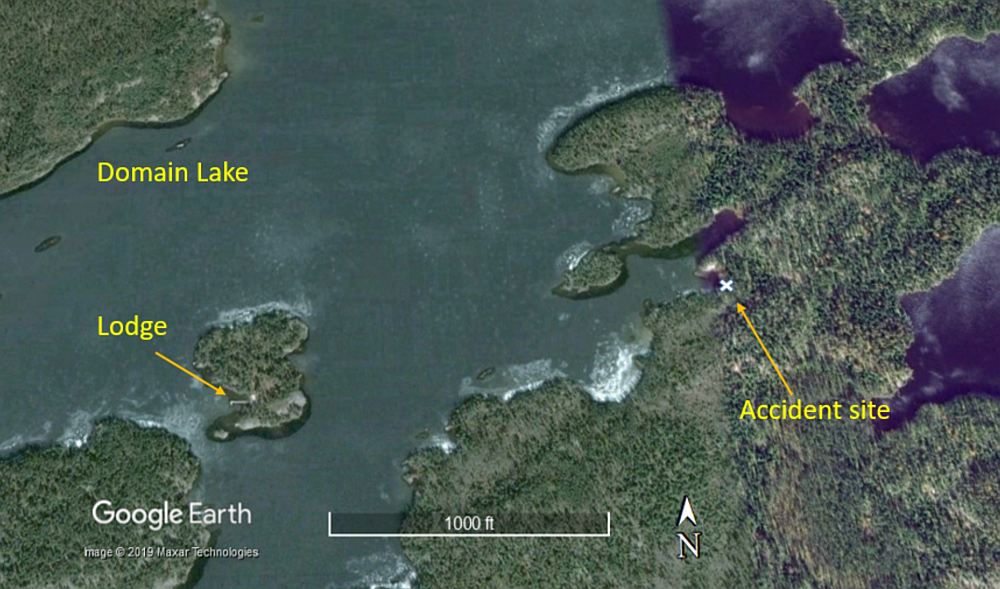
Before impacting the granite rock, the propeller cut through a tree, indicating that the propeller was rotating and that the engine was producing substantial power at the time of impact. There was no wreckage trail.
An inspection of the airframe for any pre-impact anomalies was inconclusive due to the damage sustained on impact and in the post–impact fire. An inspection of the flight control cables revealed continuity of the rudder, elevator, aileron and flap systems. The fire consumed the complete right wing, cockpit, and most of the aircraft fabric covering. Due to the fire, inspection of the right wing was limited to a flight control cable inspection, and no defects were found. The left-hand fuel cap was not found at the accident site. Examination of the floats was limited, but attachment points and wires were accounted for and showed no signs of abnormalities.
TSB Aviation Safety Study SSA93001
An aviation safety study released by the TSB in 1994 observed that
airplanes which are most frequently float equipped, such as the Piper Cub “derivatives” (J3, PA11, PA12, PA14, PA18, PA20, PA22), Cessna 172, Cessna 180, Cessna 206, Beaver, and Otter, have more fatal accidents on floats than on wheels.Footnote9
The study found that pilots with less than 100 hours on a given undercarriage configuration accounted for 38% of the accidents studied. This 38% was split between pilots with less than 100 hours of landplane experience (17% of accidents) and those with less than 100 hours of floatplane experience (21% of accidents).
The study pointed out that the 4 percentage point difference suggests that recently trained seaplane pilots may not be adequately prepared to operate that type of aircraft since they account for a higher proportion of accidents than their landplane counterparts even though they probably had acquired more total flying experience, since the majority of such pilots had landplane flying experience before upgrading to floats.
Safety message
Pilots should consider their abilities, experience, and the aircraft’s capabilities when planning and conducting flights, especially when gusty surface winds and moderate turbulence are forecast along the route of flight.
This report concludes the Transportation Safety Board of Canada’s investigation into this occurrence. The Board authorized the release of this report on 31 October 2019 . It was officially released on 05 November 2019 .
Visit the Transportation Safety Board of Canada’s website (www.tsb.gc.ca) for information about the TSB and its products and services. You will also find the Watchlist, which identifies the key safety issues that need to be addressed to make Canada’s transportation system even safer. In each case, the TSB has found that actions taken to date are inadequate, and that industry and regulators need to take additional concrete measures to eliminate the risks.
https://www.tsb.gc.ca/eng/rapports-reports/aviation/2019/a19c0053/a19c0053.html

